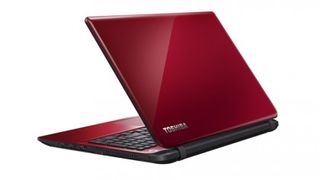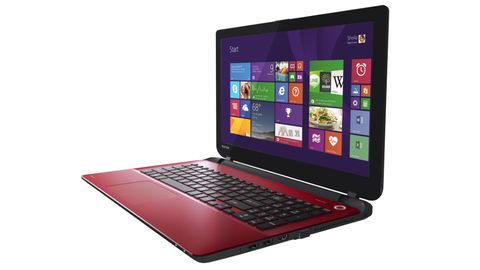Why you can trust TechRadar
- PCMark 8 Home: 1,878
- PCMark 8 Home battery life power saver 25% screen: 3 hrs 0 mins
- PC Mark 8 Home High Performance 100% screen battery life: 2 hrs 19 mins
- 3DMark: Ice Storm: 37,216; Cloud Gate: 3,884; Fire Strike: 512
- Cinebench R11.5: CPU: 117cb; Graphics: wouldn't run
- Cinebench R15: CPU: 1.54; Graphics: 11.08fps
The Core i5 chip and its 8GB of memory scored 1,878 points in PCMark 8's Home performance test. That's a reasonable result, but it's not able to match the competition: the Lenovo Flex 2 15 and its slightly faster Core i5 scored 2,254, and the AMD-powered Toshiba Satellite S50D-A-10G cantered to 2,611. There's enough power inside the L50's processor to get daily computer and general work done without complaint, but more grunt is available elsewhere.
This is no gaming system, either. In 3DMark's easiest test, Ice Storm, the Toshiba scored 37,216. That's almost 2,000 points behind the Lenovo, but it's a long way behind the 44,210 scored by the other Toshiba, which benefits from an AMD Radeon integrated graphics core. You'll be restricted to retro and indie games with the Toshiba.
The L50's battery life falls in line with the competition. We ran PCMark 8's Home test with the laptop in High Performance mode and the screen at 100% brightness, and the Toshiba lasted for 2 hours and 19 minutes. We were able to hit exactly three hours by using Power Saver mode and reducing the screen's brightness to 25%. The Toshiba's longevity is on a par with the Lenovo and a little behind the AMD-equipped Toshiba – and it's not enough for long stretches away from a plug.
The upside to modest, efficient components is decent thermal performance. During our tough stress tests the Toshiba didn't make a peep of noise, and the processor never exceeded 65°C. None of that heat made it to the outside of the chassis, either.

Screen problems
The 15.6in non-touch screen has a glossy finish and a resolution of 1,366 x 768. That's standard on budget notebooks, but it's still an annoyance – it's simply too few pixels for full HD films and proper work. It also falls behind the Lenovo, which has a 1,920 x 1,080 panel.
The Toshiba's basic screen is further highlighted by benchmark results. It gets off to a good start with a 250cd/m2 brightness level – enough to cut through the glossy coating – but the 0.72cd/m2 black level is poor, and renders deep black shades as dull greys. The contrast ratio of 347:1 is a little better than the AMD-powered Toshiba, but it's still poor.
Colours aren't just hampered by a lack of depth and contrast, either. The 7,004K colour temperature is too cool, and this screen can only handle 58.6% of the sRGB gamut, with only blue shades properly rendered. Both of those results create a cool blue cast across the entire panel.
HP has paired the screen with new Skullcandy speakers. They've got ample volume, but their decent mid-range snap is hampered by insipid bass and tinny high-end noises.
Mike has worked as a technology journalist for more than a decade and has written for most of the UK’s big technology titles alongside numerous global outlets. He loves PCs, laptops and any new hardware, and covers everything from the latest business trends to high-end gaming gear.

